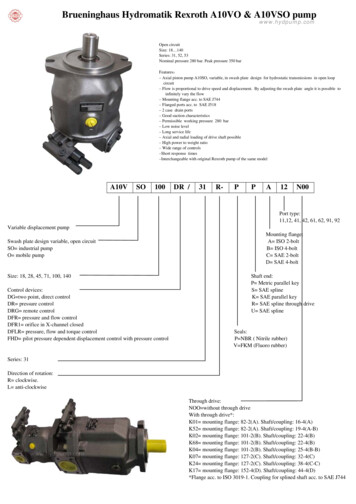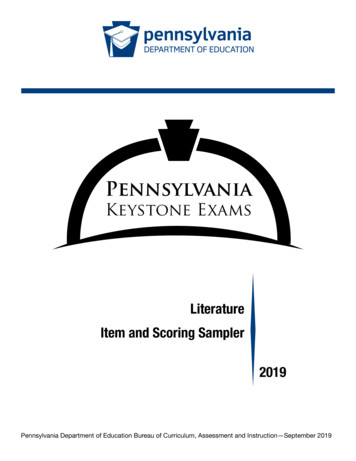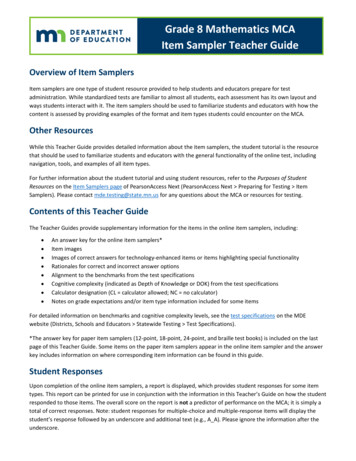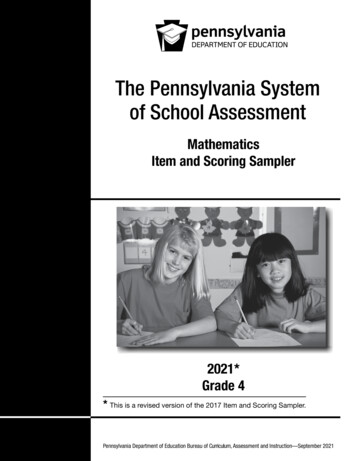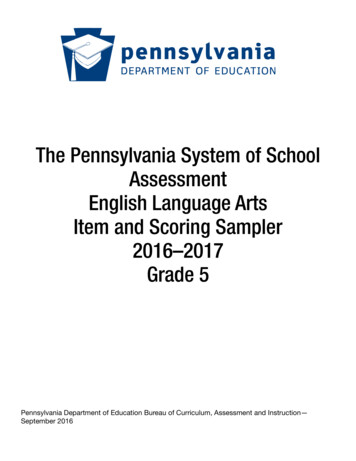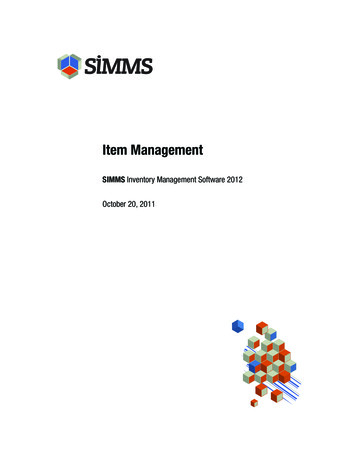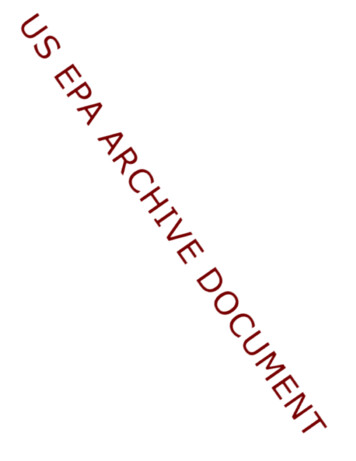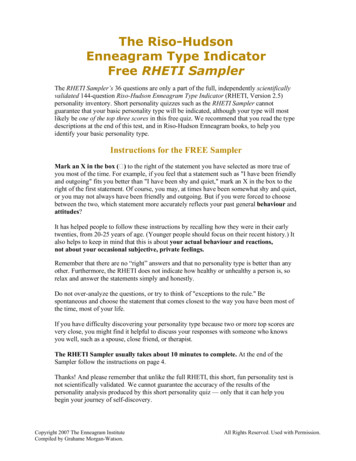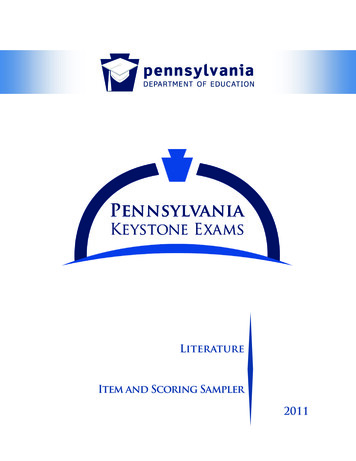
Transcription
LiteratureItem and Scoring Sampler2011
Table of ContentsI. INFORMATION ABOUT LITERATUREINTRODUCTION .3ABOUT THE KEYSTONE EXAMS .3ALIGNMENT .3KEYSTONE EXAM FORMAT .4GENERAL DESCRIPTION OF SCORING GUIDELINES FOR LITERATURE .5II. MODULE 1PASSAGE AND MULTIPLE-CHOICE QUESTIONS FOR FIRST PASSAGE SET .6CONSTRUCTED-RESPONSE QUESTION FOR FIRST PASSAGE SET .13PASSAGE AND MULTIPLE-CHOICE QUESTIONS FOR SECOND PASSAGE SET .21CONSTRUCTED-RESPONSE QUESTION FOR SECOND PASSAGE SET.29III. MODULE 2PASSAGE AND MULTIPLE-CHOICE QUESTIONS FOR FIRST PASSAGE SET .37CONSTRUCTED-RESPONSE QUESTION FOR FIRST PASSAGE SET .43PASSAGE AND MULTIPLE-CHOICE QUESTIONS FOR SECOND PASSAGE SET .51CONSTRUCTED-RESPONSE QUESTION FOR SECOND PASSAGE SET .58Pennsylvania Keystone Literature Item Sampler 20112
Information About LiteratureINTRODUCTIONThe Pennsylvania Department of Education (PDE) provides districts and schools with tools to assist indelivering focused instructional programs aligned to the state assessment system. These tools includeassessment anchor documents, assessment handbooks, and content-based item and scoring samplers. This2011 Literature Item and Scoring Sampler is a useful tool for Pennsylvania educators in the preparation of localinstructional programs and in preparing students for the Keystone Exams.This Item and Scoring Sampler contains multiple-choice items and constructed-response items that have beenwritten to align to the Keystone Assessment Anchors and Eligible Content. They provide an idea of the types ofitems that will appear on the operational Spring 2011 Keystone Exams. Each item has been through a rigorousreview process to ensure alignment with the Assessment Anchors and Eligible Content.The items in this sampler may be used as examples for creating assessment items at the classroom level, andthey may also be copied and used as part of a local instructional program.1 Classroom teachers may find itbeneficial to have students respond to the constructed-response items in this sampler. Educators can thenuse the sampler as a guide to score the responses either independently or together with colleagues within aschool or district.ABOUT THE KEYSTONE EXAMSThe Keystone Exams are end-of-course assessments designed to assess proficiency in various subject areas,including Algebra I, Algebra II, Biology, Chemistry, Civics and Government, English Composition, Geometry,Literature, U.S. History, and World History. The Keystone Exams are just one component of Pennsylvania’s highschool graduation requirements. Students must also earn state-specified credits, fulfill the state’s servicelearning and attendance requirements, and complete any additional local school system requirements toreceive a Pennsylvania high school diploma.For detailed information about how the Keystone Exams are being integrated into the Pennsylvania graduationrequirements, please contact the Pennsylvania Department of Education or visit the PDE Web site atwww.pdesas.org.ALIGNMENTThe Literature Keystone Exam consists of exam questions arranged into two modules: Fiction Literature andNonfiction Literature. Each module corresponds to specific content aligned to statements and specificationsincluded in the course-specific assessment anchor documents. The Literature content included in the KeystoneLiterature multiple-choice questions will align with the Assessment Anchors as defined by the Eligible Contentstatements. The process skills, directives, and action statements will also specifically align with the AssessmentAnchors as defined by the Eligible Content statements.The content included in Literature constructed-response items aligns with content included in the EligibleContent statements. The process skills, directives, and action statements included in the performancedemands of the Literature constructed-response items align with specifications included in the AssessmentAnchor statements, the Anchor Descriptor statements, and/or the Eligible Content statements. In other words,the verbs or action statements used in the constructed-response items or stems can come from the EligibleContent, Anchor Descriptor, or Assessment Anchor statements.1The permission to copy and/or use these materials does not extend to commercial purposes.Pennsylvania Keystone Literature Item Sampler 20113
Information About LiteratureKEYSTONE EXAM FORMATThe Literature Keystone Exam includes items that require students to select the best answer from fourpossible answer options. Students read each item and record their answers in the space provided. The correctanswer for each multiple-choice item is worth one point.The Literature Keystone Exam also includes items that require students to write responses. Students read theitem and write their responses in the spaces provided. Each constructed-response item is designed to takeabout ten minutes to complete. During an actual exam administration, students are given additional time asnecessary to complete the exam. Each constructed-response item in Literature is scored using an item-specificscoring guideline based on a 0–3-point scale. In this sampler, each item-specific scoring guideline is combinedwith sample student responses representing each score point to form a practical, item-specific scoring guide.The sampler also includes the General Description of Scoring Guidelines for Literature used to develop theitem-specific scoring guidelines. These general guidelines should be used if any additional item-specific scoringguidelines are created for use within local instructional programs.Pennsylvania Keystone Literature Item Sampler 20114
Information About LiteratureGENERAL DESCRIPTION OF SCORING GUIDELINES FOR LITERATURE3 POINTS The response provides a clear, complete, and accurate answer to the task. The response provides relevant and specific information from the passage.2 POINTS The response provides a partial answer to the task. The response provides limited information from the passage and may include inaccuracies.1 POINT The response provides a minimal answer to the task. The response provides little or no information from the passage and may include inaccuracies.OR The response relates minimally to the task.0 POINTS The response is totally incorrect or irrelevant or contains insufficient information to demonstratecomprehension.Pennsylvania Keystone Literature Item Sampler 20115
MODULE 1Read the following passage. Then answer questions 1–9.Up the Coolly1excerpt from Main-Travelled Roadsby Hamlin GarlandMr. Howard McLane in his chair let his newspaper fall on his lap, and gazed out upon itwith dreaming eyes. It had a certain mysterious glamour to him; the lakes were cooler andbrighter to his eye, the greens fresher, and the grain more golden than to anyone else, forhe was coming back to it all after an absence of ten years. It was, besides, his West. He stilltook pride in being a Western man.His mind all day flew ahead of the train to the little town, far on toward the Mississippi,where he had spent his boyhood and youth. As the train passed the Wisconsin River, with itscuriously carved cliffs, its cold, dark, swift-swirling water eating slowly under cedar-clothedbanks, Howard began to feel curious little movements of the heart.It was about six o’clock as he caught sight of the splendid broken line of hills on which hisbaby eyes had looked thirty-five years ago. A few minutes later, and the train drew up at thegrimy little station set into the hillside, and, giving him just time to leap off, plunged on againtoward the West. Howard felt a ridiculous weakness in his legs as he stepped out uponthe broiling hot, splintery planks of the station and faced the few idlers lounging about. Hesimply stood and gazed with the same intensity and absorption one of the idlers might showstanding before the Brooklyn Bridge.The town caught and held his eyes first. How poor and dull and sleepy and squalid itseemed! The one main street ended at the hillside at his left, and stretched away to thenorth, between two rows of the usual village stores, unrelieved by a tree or a touch ofbeauty. An unpaved street, with walled, drab-colored, miserable, rotting wooden buildings;the same—only worse and more squalid—was the town.The same, only more beautiful still, was the majestic amphitheater of green wooded hillsthat circled the horizon, and toward which he lifted his eyes. He thrilled at the sight.“Glorious!” he cried involuntarily.Accustomed to the White Mountains, to the Alleghanies, he had wondered if these hillswould retain their old-time charm. They did. He took off his hat to them as he stood there.Richly wooded, with gently sloping green sides, rising to massive square or founded topswith dim vistas, they glowed down upon the squat little town, gracious, lofty in their greeting,immortal in their vivid and delicate beauty.1coolly—a small valleyPennsylvania Keystone Literature Item Sampler 20116
MODULE 1He was a goodly figure of a man as he stood there beside his valise2. Portly, tall,handsomely dressed, and with something unusually winning in his brown mustache and blueeyes, something scholarly suggested by the pinch-nose glasses, something strong in therepose of the head. He smiled as he saw how unchanged was the grouping of the loaferson the salt-barrels and nail-kegs. He recognized most of them—a little more bent and a littlegrayer.They sat in the same attitudes and joked each other, breaking into short and sudden fitsof laughter, and pounded each other on the back, just as when he was a student and goingto and fro daily on the train.They ruminated on him as he passed, speculating in a perfectly audible way upon hisbusiness.“Looks like a drummer3.”“No, he ain’t no drummer. See them Boston glasses?”“That’s so. Guess he’s a teacher.”“Bos’n, I guess.”“You’re William McTurg,” Howard said, coming up to him.“I am, sir,” replied the soft-voiced giant, turning and looking down on the stranger, with anamused twinkle in big deep brown eyes. He stood tall, though his hair and beard were white.“I’m Howard McLane.”“Ye begin t’ look it,” said McTurg, removing his right hand from his pocket. “How are ye?”“I’m first-rate. How’s mother and Grant?”“Saw ’m plowing corn as I came down. Guess he’s all right. Want a boost?”“Well, yes?”“ ’Bout goin’ home. Climb right in. That’s my rig, right there,” nodding at a sleek bay colthitched in a covered buggy.They climbed into the seat after William had lowered the buggy-top and unhitched thehorse from the post. “Want to go by river, or ’round by the hills?”“Hills, I guess.”The whole matter began to seem trivial, as if he had been away only for a month or two.23valise—suitcase xxxxxxdrummer—salespersonPennsylvania Keystone Literature Item Sampler 20117
MODULE 1William McTurg was a man little given to talk. Even the coming back of a nephew didnot cause any row of questions or reminiscences. They rode in silence. He sat a little bentforward, the lines held carelessly in his hands, his great lion-like head swaying to and frowith the movement of the buggy.It all swept back upon Howard in a flood of names and faces and sights and sounds;something sweet and stirring somehow, though it had little of aesthetic4 charms at the time.They were passing along lanes now, between superb fields of corn, wherein plowmen wereat work. Kingbirds flew from post to post ahead of them; the insects called from the grass.The valley slowly outspread below them. The workmen in the fields were “turning out” for thenight.The heart of the young man swelled with pleasure almost like pain, and the eyes ofthe silent older man took on a far-off, dreaming look, as he gazed at the scene which hadrepeated itself a thousand times in his life, but of whose beauty he never spoke.Far down to the left was the break in the wall through which the river ran on its way tojoin the Mississippi. They climbed slowly among the hills, and the valley they had left grewstill more beautiful as the squalor of the little town was hid by the dusk of distance. Both menwere silent for a long time.Howard knew the peculiarities of his companion too well to make any remarks or askany questions, and besides it was a genuine pleasure to ride with one who understood thatsilence was the only speech amid such splendors.4aesthetic—pertaining to beautyMULTIPLE-CHOICE QUESTIONSL.F.1.2.31.What does the word squalid mean as used in the passage?* A. neglectedB. distantC. hecticD. bulkyThe student is asked to determine the meaning of the word “squalid.” The student must use contextclues in the passage to decide that the word means “neglected,” which is option A. Options B, C, andD are not correct meanings of the tested word.Pennsylvania Keystone Literature Item Sampler 20118
MODULE 1L.F.2.1.12.Based on information in the passage, which conclusion can be made about life inHoward’s childhood town?* A. Life is simple and characterized by hard work.B. Life is luxurious and distinguished by great wealth.C. Life is communal and filled with hectic social activities.D. Life is depressing and marked by unproductive idleness.The student is asked to draw a conclusion about what life is like for people in Howard’s childhoodtown. Based on how the author describes the town and the residents, life in the town is simple, andthe people are hard working; therefore, option A best reflects life in the town. Options B, C, and D arenot supported by the text.L.F.2.2.23.Which characteristic of the passage best indicates to the reader that it is fiction ratherthan nonfiction?A. the use of active verbsB. the use of paragraphsC. the development of a tone* D. the development of a plotThe student is asked to determine which characteristic of the passage best indicates to the readerthat it is fiction rather than informational nonfiction. Option D, “the development of a plot,” is thecharacteristic that is more often associated with fiction. Options A, B, and C could be found in bothfiction and nonfiction.Pennsylvania Keystone Literature Item Sampler 20119
MODULE 1L.F.2.3.24.Which sentence describes the relationship of the setting to the plot in the passage?A. The setting is important only at the beginning of the passage.B. The setting contributes little to the conclusion of the passage.* C. The setting influences the progression of events in the passage.D. The setting prevents the resolution of the conflict in the passage.The student is asked to analyze the relationship of the setting to the plot. The setting is a small ruraltown in the American West, which affects the scenery and people Howard observes throughout thepassage. Therefore, option C, “the setting influences the progression of events in the passage,” wouldbe correct. Options A, B, and D do not accurately reflect how the setting affects the plot.L.F.2.3.55.Which sentence from the passage most clearly conveys a nostalgic tone?* A. “It was about six o’clock as he caught sight of the splendid broken line of hills onwhich his baby eyes had looked thirty-five years ago.”B. “The one main street ended at the hillside at his left, and stretched away to thenorth, between two rows of the usual village stores, unrelieved by a tree or a touchof beauty.”C. “They climbed into the seat after William had lowered the buggy-top and unhitchedthe horse from the post.”D. “They were passing along lanes now, between superb fields of corn, whereinplowmen were at work.”The student is asked to identify which sentence from the passage most clearly conveys a nostalgictone. Option A, which recounts a memory that Howard has when looking at the landscape, mostclearly reflects a nostalgic tone. Options B, C, and D may have a slight nostalgic “feel” but not asstrong as in option A.Pennsylvania Keystone Literature Item Sampler 201110
MODULE 1L.F.2.3.66.What effect does the third person limited point of view have on the passage?A. It allows the reader to understand the motives of William McTurg.B. It allows the reader to feel sympathy for the men near the salt-barrels.C. It allows the reader to feel dislike for the relatives plowing corn in the fields.* D. It allows the reader to understand the feelings of Howard McLane.The student is asked to determine what effect the third person limited point of view has on thepassage. The point of view used allows the reader to focus on how Howard thinks and what he feelsas he travels through his childhood town; therefore, option D, which is the only option that involvesHoward’s feelings, is correct. Options A, B, and C do not reflect the effect of the point of view used inthe passage.L.F.2.4.17.This passage comes from Main-Travelled Roads, a book published in 1891. Whichsentence describes the historical significance of the passage?* A. It represents prairie life of the American Midwestern farmer during the pioneermovement.B. It shows the luxurious comfort of American train travel through the far Westernstates.C. It presents the splendor of the landscape of the Eastern part of America.D. It shows the value of education in the Western states of America.The student is asked to analyze the historical significance of the passage. The 1880s was a time ofmovement westward by pioneers in the United States. The author describes the lives of pioneerfarmers in this passage. Therefore, option A describes the historical significance of the passage.Options B, C, and D do not reflect the significance of the passage within an accurate historical context.Pennsylvania Keystone Literature Item Sampler 201111
MODULE 1L.F.2.5.18.What is the main effect of the dialect in the passage?* A. It creates a sense of realism.B. It adds a touch of humor.C. It creates a dignified mood.D. It reveals a rivalry between characters.The student is asked to identify the effect of dialect in the passage. The dialect used reflects how ruralpioneers of the 19th century may have actually spoken. Therefore, it creates a sense of realism for thereader, making option A correct. Options B, C, and D do not accurately reflect the effect of the dialectin the passage.Pennsylvania Keystone Literature Item Sampler 201112
MODULE 1CONSTRUCTED-RESPONSE QUESTIONL.F.2.3.19.Analyze what Howard’s thoughts throughout the passage reveal about his personality.Use information from the passage to support your analysis.Pennsylvania Keystone Literature Item Sampler 201113
MODULE 1ITEM-SPECIFIC SCORING GUIDELINEITEM # 9This item is reported under L.F.2, Analyzing and Interpreting Literature—FictionAssessment Anchor:L.F.2.3–Use appropriate strategies to compare, analyze, and evaluate literary elements.Specific Eligible Content addressed by this item:L.F.2.3.1–Explain, interpret, compare, describe, analyze, and/or evaluate character in a varietyof fiction.Scoring Guide:Score3210DescriptionThe response is a clear, complete, and accurate analysis of what Howard’s thoughtsthroughout the passage reveal about his personality. The response includes relevant andspecific information from the passage.The response is a partial analysis of what Howard’s thoughts throughout the passage revealabout his personality. The response includes limited information from the passage and mayinclude inaccuracies.The response is a minimal analysis of what Howard’s thoughts throughout the passage revealabout his personality. The response includes little or no information from the passage andmay include inaccuracies.ORThe response relates minimally to the task.The response is totally incorrect or irrelevant or contains insufficient information todemonstrate comprehension.Example—Top Scoring Response (3 Points):Howard’s thoughts reveal that his appreciative personality is rooted in his respect for his past. Even thoughhe has been living “out east” for years, his source of inspiration is firmly grounded in the West of hischildhood. When he is staring out the window of the train, he thinks of the passing landscape as being “hisWest.” Later on, when he accepts a ride home from his uncle, he feels like “he had been away only for amonth or two,” instead of 10 years. Finally, when he and his uncle are looking at the beauty of the fieldsand hills from the buggy, both Howard and his uncle know not to disrupt the subtle beauty of the scene bytalking.Pennsylvania Keystone Literature Item Sampler 201114
MODULE 1STUDENT RESPONSESL.F.2.3.1 Response Score: 3 points9.Analyze what Howard’s thoughts throughout the passage reveal about his personality.Use information from the passage to support your analysis.The student has given a clear, complete, and accurate analysis by stating what Howard’s thoughtsthroughout the passage reveal about his personality (“Howard’s thoughts reveal that he is sentimentalabout his hometown”). The student supports the analysis with relevant and specific information fromthe passage (“he feels pride for being a ‘Western man,’ ” “He thinks the green hills . . . are beautiful andmajestic,” and “he recognizes the men near the salt barrels and smiles because they are unchanged”).Pennsylvania Keystone Literature Item Sampler 201115
MODULE 1L.F.2.3.1 Response Score: 2 points9.Analyze what Howard’s thoughts throughout the passage reveal about his personality.Use information from the passage to support your analysis.The student has given a partial analysis by stating what Howard’s thoughts throughout the passagereveal about his personality (“Howard thinks a lot about his hometown”). The student supports theanalysis with limited information from the passage (“He feels proud to be from the West as he looks outthe train window” and “he thinks they’re beautiful”).Pennsylvania Keystone Literature Item Sampler 201116
MODULE 1L.F.2.3.1 Response Score: 2 points9.Analyze what Howard’s thoughts throughout the passage reveal about his personality.Use information from the passage to support your analysis.The student has given a partial analysis by stating what Howard’s thoughts throughout the passagereveal about his personality (“he is glad to be home” and “He also seems relaxed”). The student supportsthe analysis with limited information from the passage (“he thinks they look really nice and pretty” and“they aren’t speaking”).Pennsylvania Keystone Literature Item Sampler 201117
MODULE 1L.F.2.3.1 Response Score: 1 point9.Analyze what Howard’s thoughts throughout the passage reveal about his personality.Use information from the passage to support your analysis.The student has given a minimal analysis by stating what Howard’s thoughts throughout the passagereveal about his personality (“Howard thinks he’s a Western guy, even though he lives somewhere else”).The student uses no information from the passage to support the analysis.Pennsylvania Keystone Literature Item Sampler 201118
MODULE 1L.F.2.3.1 Response Score: 1 point9.Analyze what Howard’s thoughts throughout the passage reveal about his personality.Use information from the passage to support your analysis.The student has given a minimal analysis by stating what Howard’s thoughts throughout the passagereveal about his personality (“Howard seems glad to be home”). The student uses no information fromthe passage to support the analysis.Pennsylvania Keystone Literature Item Sampler 201119
MODULE 1L.F.2.3.1 Response Score: 09.Analyze what Howard’s thoughts throughout the passage reveal about his personality.Use information from the passage to support your analysis.The student has given a response to the task that contains insufficient information to demonstratecomprehension.Pennsylvania Keystone Literature Item Sampler 201120
MODULE 1Read the following passage. Then answer questions 10–18.excerpt from Flightsendby Linda NewberyFlightsend arrived on their doormat, in an envelope from the estate agent.“This looks interesting,” said Kathy, opening her letters by the toaster. “Here, see whatyou think.”She passed one of the printed sheets to Charlie. These arrived so often now that Charliehad stopped taking much notice. At first, she and her mother had read them all carefully,making comparisons, highlighting important points; they’d visited countless unsuitablehouses and had learned to read through estate-agent jargon. Even now, with the Soldnotice in their front garden and the buyers waiting to move in, most of the printed sheetswent straight into the recycling bin: too expensive, not enough garden, too big, too small.If a house looked promising enough for a visit, Kathy went on her own, always—so far—returning disappointed.With each reject, each sheaf of papers to hit the bin, Charlie’s hopes rose. Perhaps Mumwould give up the idea of moving. They’d take down the Sold board and stay here, close tothe town centre, close to her friends. Close to the life she knew.But the life they knew was the one Kathy wanted to get away from.On Thursday, while Charlie was at school, Kathy went to see Flightsend.“It’s perfect!” she reported. “There’ll be a lot of work, but it’s just what I’ve been waitingfor. You’ll love it, Charlie. Just wait till you see.”They went together on Saturday, a raw autumn day that was more like winter, stirringmemories of foggy mornings and afternoons dark by four-thirty.“You’ll have to navigate. These country lanes are a maze.” Kathy put the road atlason Charlie’s lap. “Here.” She pointed at a tiny black cluster around a road junction. LowerRadbourne.“It’s a long way from town,” Charlie said doubtfully. “A long way from anywhere.”Kathy craned her neck to reverse out of the driveway. “Yes! A real village.”And what am I supposed to do for a social life? Charlie wondered.As they left the town and took a country lane between hedges, Kathy sat forward, hereyes scanning the road as if her perfect house, her dream cottage, might have moved itselfcloser to surprise her. Dried leaves clung to the beech hedges on either side; an open gateshowed a muddy field entrance, rutted and puddled. Charlie saw horses sheltering in anopen-sided barn and sheep huddled against a hedge. Ahead, a ploughed field rose to a linePennsylvania Keystone Literature Item Sampler 201121
MODULE 1of tousled trees and an unpromising grey sky. Nothing looked very cheerful today, but Kathywas humming to herself as she slowed down and pulled over to the verge for a Land Rovercoming the other way. The driver raised a hand in acknowledgment; Charlie glimpsed apeaked tweed cap.“These roads are so narrow,” Kathy said. “It must be difficult getting a coach round thebends.”“Coach?”“Coach. Bus. School transport,” Kathy said.She’s made up her mind, Charlie thought, before I’ve even seen the place. Well, I’dbetter decide to like it, then.There was no one about in the village. The main street kinked at odd, awkward angles.Lower Radbourne consisted of one substantial Georgian house behind a gated wall, a tinyshop and Post Office with an OPEN sign on the door, and a scattering of cottages and smallhouses.“Here’s the church,” Kathy said. “Norman, I should think.”Charlie saw a lych-gate set in a hedge; farther back, gravestones and a sturdy buildingwith a tower and an arched porch. Kathy turned sharp right down a track beside thechurchyard wall, then pulled up.“This is it!”They got out of the car. Charlie turned up her coat collar against the wind. The cottage,uninhabited for six months and wearing an air of abandonment, stood alone, sheltered bythe churchyard yews. There was a tangled front garden, with a gate that hung lopsidedlyfrom one hinge. Flightsend had blank, staring windows, and a porch that would probablycollapse if no one did anything about it. In need of renovation, Charlie thought. And soon.“What does it mean, Flightsend?” she asked.“I don’t know. Flightsend. Flight’s End. Well, that’s what it is, isn’t it? An end to—well, toeverything that’s gone wrong.”Charlie thought: I don’t want ends. I want beginnings. The gloom of the place settledround her like fog. She thought of long winter evenings marooned here, miles from herfriends. We’ll be castaways, she thought, me and Mum. Flight’s End was making her thinknot of settled contentment but of clipped wings, of pinioned birds.“Perhaps it’s to do with the old airfield,” Kathy said, shoving the wonky gate aside.“But the house is much older than the airfield,” Charlie pointed out. “A hundred and fiftyyears old, the blurb says. Aeroplanes hadn’t been invented then, had they? Not even thoseancient ones with wings that people flapped with their arms. How old’s the airfield?”“Wartime, I should think. Someone renamed the house later, perhaps. It’s a nice name,anyway. I like it.”Pennsylvania Keystone Literature Item Sampler 201122
MODULE 1But as for the cottage itself—Charlie couldn’t imagine it as anyone’s home, let aloneher home. She saw only dilapidation and neglect. The house was perfectly symmetrical,like a child’s drawing: the front door and porch, windows either side, two bedroom windowsabove, chimney-stacks each side of a tiled roof crusted with lichens. A weedy gravelledpath led to the open-fronted porch and a door that had curls of paint peeling off; the nearestwindow showed a bare, gloomy main room that was probably full of cobwebs
including Algebra I, Alge bra II, Biology, Chemistry, Civics and Government, English Compositi on, Geometry, Literature, U.S. History, and World History. The Keystone Exams are just one component of Pennsylvania's high school graduati on requirements. Students must also earn state-specifi ed credits, fulfi ll the state's service-
